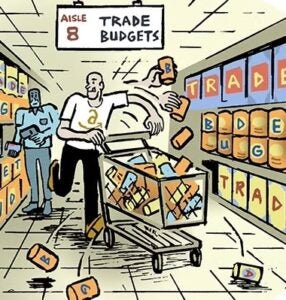The Trade Desk reported strong numbers in its quarterly earnings on Thursday, with revenue growth of 25% YoY at $493 million and profit up from $16 million in Q3 2022 to $39 million this year.
The good topline results were washed out, though, as investors reacted to The Trade Desk’s pessimistic guidance for Q4, which cautions of a slowdown in ad spend. The company’s share value plummeted by more than 25% – or about $10 billion – in just an hour between when the company published its earnings documents and when TTD execs spoke with investors.
Don’t blame the messenger, was CEO Jeff Green’s message to investors.
The macro problem
TTD represents every one of the Ad Age top 200 advertisers, either directly or via their agencies, Green said, as well as most of the S&P 500. “That means that we represent nearly every major sector of the economy as well.”
In other words, he argues, the scaled DSP is, in some ways, the canary in the coalmine for macroeconomic woe.
“So that said, starting about the second week of October, we began to see some transitory cautiousness around certain advertisers,” according to Green.
Some categories make sense for a slowdown. Media and entertainment, for instance, haven’t produced new shows and movies, and actors haven’t been promoting content following dual strikes. Automotive brands, which also are dealing with a strike among labor and factory workers, and consumer electronic companies have reduced spend now and for the rest of the year, he said.
TTD company is “cautiously optimistic” that the resolution of the auto workers’ strike and the strikes in Hollywood will stabilize spend, said CFO Laura Schenkein.
But if fewer cars (or TV shows) were produced in Q3, there’s simply less for marketers to sell.
TTD’s two growing priorities – retail media and CTV, ever heard of them? – are largely unaffected by the softening ad market, he said. But a few large advertiser categories are, internally, preparing for a low-spending Q4.
Growing pains
Aside from economic caution, investors pressed TTD about the strength of retail and CTV.
On CTV, equity analyst Laura Martin from Needham pressed whether programmers will shift more inventory from current direct sold and direct guarantees to biddable programmatic campaigns.
Leaders from Disney, Fox and Paramount prefer to sell directly and seem reticent of open, biddable programmatic, Martin said. What makes Green think that’s where CTV inventory will go, rather than private marketplaces or direct deals?
“I suppose it depends on who you ask inside of those premium content owners,” Green responded. “But, to me, the math is fairly obvious and, even conceptually, fairly obvious.”
Advertisers prefer biddable media, he continued, because that’s where they can use their data and broadcaster data to effectively target ads. The CPMs are greater – and with fewer ads per hour and ad-free subscribers out there, programmers must eke every drop of value from their inventory.
“Inside all those big content companies, there are groups of people that understand that’s where we’re all heading, even though not necessarily everybody gets that the traditional models of selling are not the best ways to monetize television going forward,” he said.
On retail media, too, TTD still must win a long campaign of persuasion and education to get retailers to see the world from an open programmatic point of view.
Some major chains have begun opening up their purchase and attribution data to advertisers and allow their ad platforms to be targeted using third-party ad IDs, such as Unified ID 2.0.
“This is a case where economic pressures have helped them to be bold and daring and do things that they haven’t done before,” Green said of retailers like Albertson’s, Walgreens, Dollar General and Macy’s, which all use TTD for audience extensions and allow sales attribution on open programmatic campaigns.
If and when retailers – even potentially Amazon – open up their sales data to advertising attribution, Green said, “it will be better for everyone, including – and especially – themselves.”












